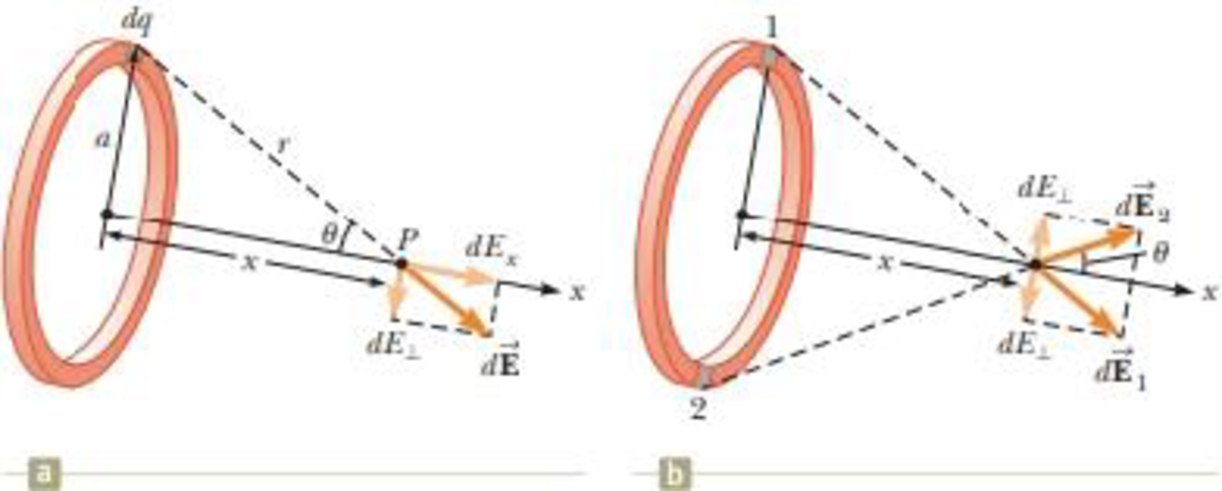
Concept explainers
Show that the maximum magnitude Emax of the electric field along the axis of a uniformly charged ring occurs at

Figure 23.3 (Example 23.2) A uniformly charged ring of radius c. (a) The field at P on the x axis due to an element of charge dq. (b) The perpendicular component of the field at P due to segment 1 is canceled by the perpendicular component due to segment 2.
Trending nowThis is a popular solution!

Chapter 23 Solutions
Bundle: Physics For Scientists And Engineers With Modern Physics, 10th + Webassign Printed Access Card For Serway/jewett's Physics For Scientists And Engineers, 10th, Multi-term
Additional Science Textbook Solutions
College Physics: A Strategic Approach (3rd Edition)
Human Biology: Concepts and Current Issues (8th Edition)
Fundamentals Of Thermodynamics
Loose Leaf For Integrated Principles Of Zoology
Chemistry: An Introduction to General, Organic, and Biological Chemistry (13th Edition)
Cosmic Perspective Fundamentals
- Two objects get pushed by the same magnitude of force. One object is 10x more massive. How does the rate of change of momentum for the more massive object compare with the less massive one? Please be able to explain why in terms of a quantitative statement found in the chapter.arrow_forwardA box is dropped on a level conveyor belt that is moving at 4.5 m/s in the +x direction in a shipping facility. The box/belt friction coefficient is 0.15. For what duration will the box slide on the belt? In which direction does the friction force act on the box? How far will the box have moved horizontally by the time it stops sliding along the belt?arrow_forwardNo chatgpt pls will upvotearrow_forward
- No chatgpt pls will upvotearrow_forwardA toy car speeds up at 1.0 m/s2 while rolling down a ramp, and slows down at a rate of 2.0 m/s2 while rolling up the same ramp. What is the slope of the ramp in degrees? Grade in %? The friction coefficient?arrow_forwardPlz solution should be complete No chatgpt pls will upvote .arrow_forward
- A box with friction coefficient of 0.2 rests on a 12 foot long plank of wood. How high (in feet) must one side of the plank be lifted in order for the box to begin to slide?arrow_forwardWhat is a good general rule to follow in order to find the best choice of coordinate system to solve a dynamics problem?arrow_forwardWhat is the meaning of a first order approximation?arrow_forward
 Principles of Physics: A Calculus-Based TextPhysicsISBN:9781133104261Author:Raymond A. Serway, John W. JewettPublisher:Cengage Learning
Principles of Physics: A Calculus-Based TextPhysicsISBN:9781133104261Author:Raymond A. Serway, John W. JewettPublisher:Cengage Learning Physics for Scientists and Engineers: Foundations...PhysicsISBN:9781133939146Author:Katz, Debora M.Publisher:Cengage Learning
Physics for Scientists and Engineers: Foundations...PhysicsISBN:9781133939146Author:Katz, Debora M.Publisher:Cengage Learning Physics for Scientists and EngineersPhysicsISBN:9781337553278Author:Raymond A. Serway, John W. JewettPublisher:Cengage Learning
Physics for Scientists and EngineersPhysicsISBN:9781337553278Author:Raymond A. Serway, John W. JewettPublisher:Cengage Learning Physics for Scientists and Engineers with Modern ...PhysicsISBN:9781337553292Author:Raymond A. Serway, John W. JewettPublisher:Cengage Learning
Physics for Scientists and Engineers with Modern ...PhysicsISBN:9781337553292Author:Raymond A. Serway, John W. JewettPublisher:Cengage Learning College PhysicsPhysicsISBN:9781285737027Author:Raymond A. Serway, Chris VuillePublisher:Cengage Learning
College PhysicsPhysicsISBN:9781285737027Author:Raymond A. Serway, Chris VuillePublisher:Cengage Learning Physics for Scientists and Engineers, Technology ...PhysicsISBN:9781305116399Author:Raymond A. Serway, John W. JewettPublisher:Cengage Learning
Physics for Scientists and Engineers, Technology ...PhysicsISBN:9781305116399Author:Raymond A. Serway, John W. JewettPublisher:Cengage Learning





